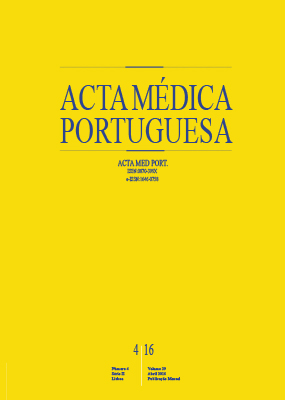Prevalence of Late Preterm and Early Term Birth in Portugal
DOI:
https://doi.org/10.20344/amp.6523Keywords:
Infant Mortality, Infant, Premature, Portugal, Premature Birth, Prevalence, Surveys and Questionnaires.Abstract
Introduction: Late preterm birth (defined as birth between 34 and 36 complete weeks’ gestation) and early term birth (defined as birth between 37 and 38 complete weeks’ gestation) have become a topic of recent discussion as the morbidity associated with delivery at these gestational ages has become increasingly evident. Our objective was to evaluate the characteristics of late preterm and early term birth in Portugal.
Material and Methods: We developed a survey questionnaire that was sent to the Obstetric Department of all public hospitals in Portugal. The questionnaire consisted on questions on prevalence and mode of delivery of late preterm and early term period and associated neonatal morbidity and mortality. The questions referred solely to single births occurred during 2013.
Results: We received completed questionnaires from 14 hospitals, corresponding to nearly one third (33.5%) of total deliveries in Portugal. We report 5.4% of late preterm and 27% of early term deliveries. Approximately two thirds of late preterm and three quarters of early term deliveries were spontaneous. The cesarean section rate was higher in late preterm (39.1%) than in early term (26.4%) births. Neonatal complications were more frequent in late preterm neonates (34.2%) when compared to early term neonates (14.2%).
Discussion: The prevalence of late preterm and early term birth in our cohort is comparable, although slightly reduced, to other published series.
Conclusion: The obstetric community should raise efforts to limit deliveries below 39 weeks’ gestation to the ones with a valid medical indication.
Downloads
Downloads
Published
How to Cite
Issue
Section
License
All the articles published in the AMP are open access and comply with the requirements of funding agencies or academic institutions. The AMP is governed by the terms of the Creative Commons ‘Attribution – Non-Commercial Use - (CC-BY-NC)’ license, regarding the use by third parties.
It is the author’s responsibility to obtain approval for the reproduction of figures, tables, etc. from other publications.
Upon acceptance of an article for publication, the authors will be asked to complete the ICMJE “Copyright Liability and Copyright Sharing Statement “(http://www.actamedicaportuguesa.com/info/AMP-NormasPublicacao.pdf) and the “Declaration of Potential Conflicts of Interest” (http:// www.icmje.org/conflicts-of-interest). An e-mail will be sent to the corresponding author to acknowledge receipt of the manuscript.
After publication, the authors are authorised to make their articles available in repositories of their institutions of origin, as long as they always mention where they were published and according to the Creative Commons license.









